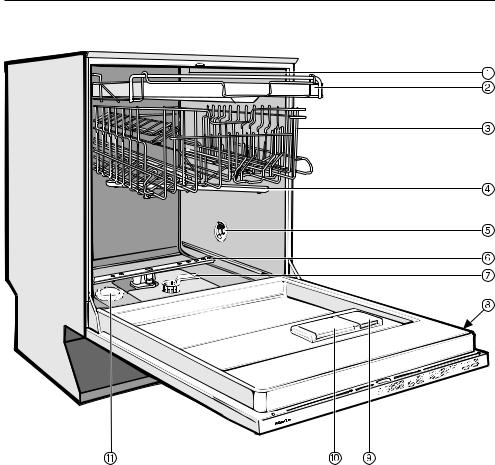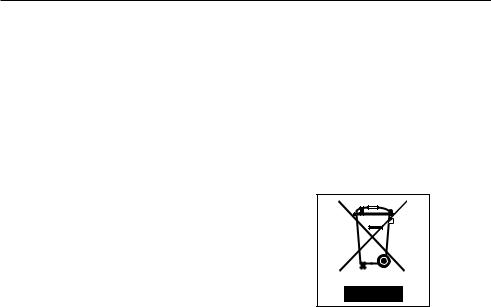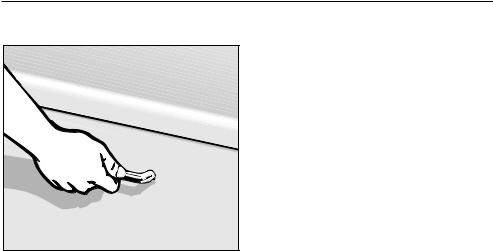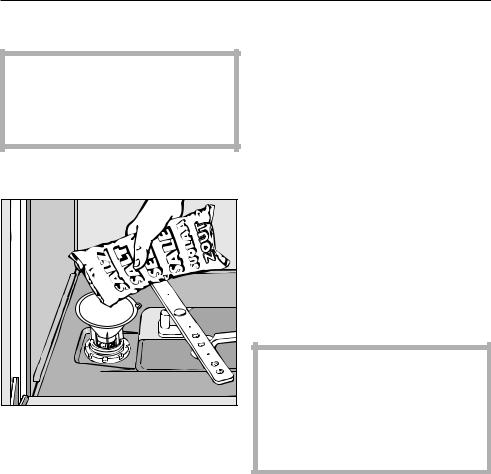Miele G5280, G5285, G5370, G5375 Operating instructions

Operating instructions
for dishwashers
To avoid the risk of accidents or |
en - GB |
damage to the appliance, it is |
|
essential to read these instructions |
|
as well as the installation plan before |
|
it is installed and used for the |
|
first time. |
M.-Nr. 09 255 970 |

Contents
Description of the appliance. . . . . . . . . . . . . . . . . . . . . . . . . . . . . . . . . . . . . . . . . 5 Appliance overview . . . . . . . . . . . . . . . . . . . . . . . . . . . . . . . . . . . . . . . . . . . . . . . . . 5 Control panel . . . . . . . . . . . . . . . . . . . . . . . . . . . . . . . . . . . . . . . . . . . . . . . . . . . . . . 6
Warning and Safety instructions . . . . . . . . . . . . . . . . . . . . . . . . . . . . . . . . . . . . . 7
Caring for our environment . . . . . . . . . . . . . . . . . . . . . . . . . . . . . . . . . . . . . . . . 17 Disposal of the packing
material . . . . . . . . . . . . . . . . . . . . . . . . . . . . . . . . . . . . . . . . . . . . . . . . . . . . . . . . . 17 Disposal of your old appliance . . . . . . . . . . . . . . . . . . . . . . . . . . . . . . . . . . . . . . . 17 Energy saving dishwashing . . . . . . . . . . . . . . . . . . . . . . . . . . . . . . . . . . . . . . . . . . 18
Before using for the first time. . . . . . . . . . . . . . . . . . . . . . . . . . . . . . . . . . . . . . . 19 To open the door . . . . . . . . . . . . . . . . . . . . . . . . . . . . . . . . . . . . . . . . . . . . . . . . . . 19 To close the door . . . . . . . . . . . . . . . . . . . . . . . . . . . . . . . . . . . . . . . . . . . . . . . . . . 19 Water softener . . . . . . . . . . . . . . . . . . . . . . . . . . . . . . . . . . . . . . . . . . . . . . . . . . . . 20 Programming the water hardness level . . . . . . . . . . . . . . . . . . . . . . . . . . . . . . 21 Before using the appliance for the first time, you require:. . . . . . . . . . . . . . . . . . . 22 Filling the salt reservoir . . . . . . . . . . . . . . . . . . . . . . . . . . . . . . . . . . . . . . . . . . . . . 22 Salt indicator . . . . . . . . . . . . . . . . . . . . . . . . . . . . . . . . . . . . . . . . . . . . . . . . . . . . . 23 Switching off the refill indicators . . . . . . . . . . . . . . . . . . . . . . . . . . . . . . . . . . . . 24 Rinse aid . . . . . . . . . . . . . . . . . . . . . . . . . . . . . . . . . . . . . . . . . . . . . . . . . . . . . . . . 25 Adding rinse aid . . . . . . . . . . . . . . . . . . . . . . . . . . . . . . . . . . . . . . . . . . . . . . . . . . 25 Rinse aid indicator . . . . . . . . . . . . . . . . . . . . . . . . . . . . . . . . . . . . . . . . . . . . . . . . . 26 Setting the rinse aid dosage . . . . . . . . . . . . . . . . . . . . . . . . . . . . . . . . . . . . . . . . . 27
Loading the dishwasher . . . . . . . . . . . . . . . . . . . . . . . . . . . . . . . . . . . . . . . . . . . 28 Items not suitable for dishwashers: . . . . . . . . . . . . . . . . . . . . . . . . . . . . . . . . . . . . 29 Upper basket . . . . . . . . . . . . . . . . . . . . . . . . . . . . . . . . . . . . . . . . . . . . . . . . . . . . . 30 Cup rack (depending on model) . . . . . . . . . . . . . . . . . . . . . . . . . . . . . . . . . . . 30 Adjusting the upper basket . . . . . . . . . . . . . . . . . . . . . . . . . . . . . . . . . . . . . . . 31 Lower basket . . . . . . . . . . . . . . . . . . . . . . . . . . . . . . . . . . . . . . . . . . . . . . . . . . . . . 32 MultiComfort area . . . . . . . . . . . . . . . . . . . . . . . . . . . . . . . . . . . . . . . . . . . . . . . 33 Hinged spikes (depending on model) . . . . . . . . . . . . . . . . . . . . . . . . . . . . . . . 33 Cutlery . . . . . . . . . . . . . . . . . . . . . . . . . . . . . . . . . . . . . . . . . . . . . . . . . . . . . . . . . . 34 Cutlery tray (depending on model). . . . . . . . . . . . . . . . . . . . . . . . . . . . . . . . . . 34 Cutlery basket (depending on model) . . . . . . . . . . . . . . . . . . . . . . . . . . . . . . . 35
Operation . . . . . . . . . . . . . . . . . . . . . . . . . . . . . . . . . . . . . . . . . . . . . . . . . . . . . . . 36 Detergent . . . . . . . . . . . . . . . . . . . . . . . . . . . . . . . . . . . . . . . . . . . . . . . . . . . . . . . . 36 Adding detergent. . . . . . . . . . . . . . . . . . . . . . . . . . . . . . . . . . . . . . . . . . . . . . . . . . 38 Switching on . . . . . . . . . . . . . . . . . . . . . . . . . . . . . . . . . . . . . . . . . . . . . . . . . . . . . 40 Selecting a programme . . . . . . . . . . . . . . . . . . . . . . . . . . . . . . . . . . . . . . . . . . . . . 40
2

Contents
Starting the programme . . . . . . . . . . . . . . . . . . . . . . . . . . . . . . . . . . . . . . . . . . . . . 40 Time display. . . . . . . . . . . . . . . . . . . . . . . . . . . . . . . . . . . . . . . . . . . . . . . . . . . . . . 41 Standby . . . . . . . . . . . . . . . . . . . . . . . . . . . . . . . . . . . . . . . . . . . . . . . . . . . . . . . . . 41 At the end of the programme. . . . . . . . . . . . . . . . . . . . . . . . . . . . . . . . . . . . . . . . . 42 Switching off . . . . . . . . . . . . . . . . . . . . . . . . . . . . . . . . . . . . . . . . . . . . . . . . . . . . . 42 Unloading the dishwasher . . . . . . . . . . . . . . . . . . . . . . . . . . . . . . . . . . . . . . . . . . . 42 Interrupting a programme . . . . . . . . . . . . . . . . . . . . . . . . . . . . . . . . . . . . . . . . . . . 43 Changing a programme . . . . . . . . . . . . . . . . . . . . . . . . . . . . . . . . . . . . . . . . . . . . 43
Additional functions . . . . . . . . . . . . . . . . . . . . . . . . . . . . . . . . . . . . . . . . . . . . . . 44 Turbo . . . . . . . . . . . . . . . . . . . . . . . . . . . . . . . . . . . . . . . . . . . . . . . . . . . . . . . . . . . 44 DetergentAgent . . . . . . . . . . . . . . . . . . . . . . . . . . . . . . . . . . . . . . . . . . . . . . . . . . . 44 Delay start . . . . . . . . . . . . . . . . . . . . . . . . . . . . . . . . . . . . . . . . . . . . . . . . . . . . . . . 45 Buzzer . . . . . . . . . . . . . . . . . . . . . . . . . . . . . . . . . . . . . . . . . . . . . . . . . . . . . . . . . . 47 Adjust Sensor wash . . . . . . . . . . . . . . . . . . . . . . . . . . . . . . . . . . . . . . . . . . . . . . . . 48 Memory . . . . . . . . . . . . . . . . . . . . . . . . . . . . . . . . . . . . . . . . . . . . . . . . . . . . . . . . . 49 Optimise standby. . . . . . . . . . . . . . . . . . . . . . . . . . . . . . . . . . . . . . . . . . . . . . . . . . 50 Factory default . . . . . . . . . . . . . . . . . . . . . . . . . . . . . . . . . . . . . . . . . . . . . . . . . . . . 51
Cleaning and care . . . . . . . . . . . . . . . . . . . . . . . . . . . . . . . . . . . . . . . . . . . . . . . . 52 Cleaning the wash cabinet . . . . . . . . . . . . . . . . . . . . . . . . . . . . . . . . . . . . . . . . . . 52 Cleaning the door and the door seal . . . . . . . . . . . . . . . . . . . . . . . . . . . . . . . . . . . 52 Cleaning the control panel and door front . . . . . . . . . . . . . . . . . . . . . . . . . . . . . . . 53 Cleaning the filters in the wash cabinet . . . . . . . . . . . . . . . . . . . . . . . . . . . . . . . . . 54 Cleaning the spray arms . . . . . . . . . . . . . . . . . . . . . . . . . . . . . . . . . . . . . . . . . . . . 56
Problem solving guide . . . . . . . . . . . . . . . . . . . . . . . . . . . . . . . . . . . . . . . . . . . . 57 Technical problems . . . . . . . . . . . . . . . . . . . . . . . . . . . . . . . . . . . . . . . . . . . . . . . . 57 Water inlet/drain fault . . . . . . . . . . . . . . . . . . . . . . . . . . . . . . . . . . . . . . . . . . . . . . . 59 General problems . . . . . . . . . . . . . . . . . . . . . . . . . . . . . . . . . . . . . . . . . . . . . . . . . 60 Noises . . . . . . . . . . . . . . . . . . . . . . . . . . . . . . . . . . . . . . . . . . . . . . . . . . . . . . . . . . 61 Unsatisfactory washing result . . . . . . . . . . . . . . . . . . . . . . . . . . . . . . . . . . . . . . . . 62
Maintenance . . . . . . . . . . . . . . . . . . . . . . . . . . . . . . . . . . . . . . . . . . . . . . . . . . . . . 65 Cleaning the water inlet filter . . . . . . . . . . . . . . . . . . . . . . . . . . . . . . . . . . . . . . . . . 65 Cleaning the drain pump and non-return valve . . . . . . . . . . . . . . . . . . . . . . . . . . . 66
After sales service . . . . . . . . . . . . . . . . . . . . . . . . . . . . . . . . . . . . . . . . . . . . . . . . 67 Repairs . . . . . . . . . . . . . . . . . . . . . . . . . . . . . . . . . . . . . . . . . . . . . . . . . . . . . . . 67 Guarantee . . . . . . . . . . . . . . . . . . . . . . . . . . . . . . . . . . . . . . . . . . . . . . . . . . . . . 67 Future updates . . . . . . . . . . . . . . . . . . . . . . . . . . . . . . . . . . . . . . . . . . . . . . . . . 67 For testing institutes. . . . . . . . . . . . . . . . . . . . . . . . . . . . . . . . . . . . . . . . . . . . . . . . 67
3

Contents
Programme chart . . . . . . . . . . . . . . . . . . . . . . . . . . . . . . . . . . . . . . . . . . . . . . . . . 68
Optional accessories. . . . . . . . . . . . . . . . . . . . . . . . . . . . . . . . . . . . . . . . . . . . . . 72
Electrical connection. . . . . . . . . . . . . . . . . . . . . . . . . . . . . . . . . . . . . . . . . . . . . . 73
Plumbing. . . . . . . . . . . . . . . . . . . . . . . . . . . . . . . . . . . . . . . . . . . . . . . . . . . . . . . . 74 The Miele waterproof anti-leak system . . . . . . . . . . . . . . . . . . . . . . . . . . . . . . . . . 74 Connection to the water supply . . . . . . . . . . . . . . . . . . . . . . . . . . . . . . . . . . . . . . . 74 Drainage . . . . . . . . . . . . . . . . . . . . . . . . . . . . . . . . . . . . . . . . . . . . . . . . . . . . . . . . 75
Technical data . . . . . . . . . . . . . . . . . . . . . . . . . . . . . . . . . . . . . . . . . . . . . . . . . . . 76
4

Description of the appliance
Appliance overview
Upper spray arm (not visible) |
Filter combination |
Cutlery tray (depending on model) |
Data plate |
Upper basket |
Rinse aid reservoir |
Middle spray arm |
Dual compartment detergent |
Air inlet for drying |
dispenser |
|
|
(depending on model) |
Salt reservoir |
Lower spray arm |
|
5

Description of the appliance
Control panel
Check/Refill indicators |
Programmes |
Time display |
Programme selector button |
Delay start button |
On/Off button with indicator light |
with indicator light |
|
Turbo button with indicator light |
|
This instruction book applies to several different dishwasher models. The specific dishwasher models are referred to as follows:
Standard |
= |
80.5 cm high dishwashers (integrated) |
|
|
and 84.5 cm high dishwashers (freestanding) |
XXL |
= |
84.5 cm high dishwashers |
6

Warning and Safety instructions
This appliance conforms to current safety requirements. Inappropriate use can, however, lead to personal injury and damage to property.
To avoid the risk of accidents and damage to the appliance, please read these instructions carefully before using it for the first time. They contain important information on its safety, use and maintenance.
Keep these instructions in a safe place and pass them on to any future owner.
Correct application
This dishwasher is not designed for commercial use. It is intended for use in domestic households and in similar working and residential environments.
The dishwasher is not intended for outdoor use.
It must only be used as a domestic appliance as specified in these operating instructions, for cleaning domestic crockery and cutlery.
Any other usage is not supported by the manufacturer and could be dangerous. Miele cannot be held liable for damage resulting from incorrect or improper use or operation.
The appliance can only be used by people with reduced physical, sensory or mental capabilities, or lack of experience and knowledge, if they are supervised whilst using it, or have been shown how to use it in a safe way and understand the hazards involved.
7

Warning and Safety instructions
Safety with children
Children under 8 years of age must be kept away from the appliance unless they are constantly supervised.
Children 8 years and older may only use the dishwasher if they have been shown how to use it in a safe way and understand the hazards involved.
Children must not be allowed to clean or maintain the appliance unsupervised.
Keep very young children away from it at all times and supervise them whilst you are using it. To prevent the risk of injury, do not allow them to play with it or use the controls. There is a danger that children playing might shut themselves in the dishwasher.
Keep children away from detergents. Dishwasher detergents contain irritant and corrosive ingredients which can cause burning in the mouth, nose and throat if swallowed, or inhibit breathing. Keep children away from the dishwasher when the door is open. There could still be detergent residues in the cabinet.
Seek medical attention immediately if your child has swallowed or inhaled detergent.
8

Warning and Safety instructions
Technical safety
Before setting up the appliance, check it for any externally visible damage. Under no circumstances should you use a damaged appliance. It could be dangerous.
The dishwasher must only be plugged into the electricity supply via a suitable switched socket. The electrical socket must be easily accessible after the dishwasher is installed so that it can be disconnected from the electricity supply at any time. (See "Electrical connection").
There must be no electrical sockets behind the dishwasher. Danger of overheating and fire risk if the dishwasher were to be pushed up against a plug.
The dishwasher must not be installed under a hob. The high radiant temperatures which are sometimes generated by a hob could damage the dishwasher. For the same reason it should not be installed next to open fires or other appliances which give off heat, such as heaters etc.
Do not connect the dishwasher to the mains supply until it has been fully installed and any adjustment has been made to the door springs.
9

Warning and Safety instructions
Before connecting the appliance, check that the connection data on the data plate (voltage and frequency) match the mains electricity supply. If in any doubt, consult a qualified electrician.
The electrical safety of this appliance can only be guaranteed if correctly earthed. It is most important that this basic safety requirement is observed and regularly tested and where there is any doubt the electrical system in the house should be checked by a qualified electrician.
The manufacturer cannot be held liable for the consequences of an inadequate earthing system (e.g. electric shock).
Do not connect the appliance to the mains electricity supply by a multi-socket adapter or an extension lead. These do not guarantee the required safety of the appliance (e.g. danger of overheating).
The appliance must not be used in a non-stationary location (e.g. on a ship).
Do not install the dishwasher in a room where there is a risk of frost. Frozen hoses may burst or split. The reliability of the electronic control unit may be impaired at temperatures below freezing point.
10

Warning and Safety instructions
The plastic housing of the water connection contains an electrical component. The housing must not be dipped in water.
There are electrical wires in the water inlet hose. Do not cut the water inlet hose, even if it is too long.
The integrated Waterproof System offers protection from water damage, provided the following conditions are met:
–The dishwasher is correctly installed and plumbed in.
–The dishwasher is properly maintained and parts are replaced where it can be seen that this is necessary.
–The stopcock has been turned off when the appliance is not used for a longer period of time (e.g. during holidays).
The Waterproof system will work even if the appliance is switched off. However, the appliance must remain connected to the electricity supply.
A damaged dishwasher could be dangerous. If the dishwasher gets damaged, switch it off at the mains and call your Miele Dealer or the Miele Service Department.
11

Warning and Safety instructions
Unauthorised repairs could result in unforeseen dangers for the user, for which Miele cannot accept liability. Repairs should only be undertaken by a Miele approved service technician, otherwise any subsequent damage will not be covered by the guarantee.
Faulty components must only be replaced by genuine Miele original spare parts. Only when these parts are fitted can Miele guarantee the safety standards of the appliance.
Always disconnect the dishwasher from the electrical supply for maintenance work (switch off at the wall socket and remove the plug).
If the connection cable is damaged it must be replaced with a special cable available from Miele. For safety reasons this must only be fitted by Miele Service or a Miele approved service technician.
In areas which may be subject to infestation by cockroaches or other vermin, pay particular attention to keeping the appliance and its surroundings in a clean condition at all times. Any damage which may be caused by cockroaches or other vermin will not be covered by the guarantee.
12

Warning and Safety instructions
Correct installation
The dishwasher must be installed and connected in compliance with the diagram supplied.
Take care, both before and during installation of the dishwasher, not to cut yourself on the metal parts. Danger of injury. Wear protective gloves.
The dishwasher must be correctly aligned to ensure problem-free operation.
In order to ensure stability, built-under and integrated dishwashers must only be installed under a continuous worktop which is secured to adjacent cabinetry.
If you want to convert your freestanding dishwasher to a
built-under ("U") model, you will need to order the appropriate conversion kit. If you remove the existing plinth, you must replace it with a U-model plinth. This is necessary to avoid the risk of injury caused by protruding metal parts.
The door springs must be adjusted equally on both sides. They are correctly adjusted when the door remains stationary when left open at 45°. It is important that the door is held in place by the springs and cannot fall open.
13

Warning and Safety instructions
Correct use
Do not use solvents in the dishwasher. Danger of explosion.
Do not inhale or ingest dishwasher detergent. Dishwasher detergents contain irritant or corrosive ingredients which can cause burning in the nose, mouth and throat if swallowed, or inhibit breathing. Seek medical attention immediately if detergent has been swallowed or inhaled.
Avoid leaving the door open unnecessarily, as you could trip over
it.
Dishes can be very hot at the end of the programme.
Allow them to cool until they are comfortable enough to handle before unloading.
Do not sit or lean on the opened door. This could cause the dishwasher to tip and be damaged, and you could get injured.
Only use detergent and rinse aid formulated for domestic dishwashers. Do not use washing-up liquid.
Do not use commercial or industrial detergents as these may cause damage, and there is a risk of severe chemical reaction.
14

Warning and Safety instructions
Do not fill the rinse aid reservoir with powder or liquid detergent. This will cause serious damage to the reservoir.
Do not fill the salt reservoir with powder or liquid dishwasher detergent. This will damage the water softener. Make sure you have picked up the correct packet of dishwasher salt before filling the salt reservoir!
Only use special coarse grained dishwasher salt for reactivation, as other salts may contain insoluble additives which can impair the functioning of the water softener.
In an appliance with a cutlery basket (depending on model) cutlery is cleaned and dried more efficiently if placed in the basket with the handles downwards. However, to avoid the risk of injury, place knives and forks etc. with the handles upwards.
Plastic items which cannot withstand being washed in hot water, such as disposable plastic containers, or plastic cutlery and crockery should not be cleaned in the dishwasher. The high temperatures in the dishwasher may cause them to melt or lose shape.
On models with "Delay start", make sure that the dispenser is dry before adding detergent. Wipe dry if necessary. Detergent will clog if poured into a damp dispenser and may not be thoroughly dispersed.
15

Warning and Safety instructions
Accessories
Only use genuine Miele original spare parts and accessories with this dishwasher. Using spare parts or accessories from other manufacturers will invalidate the guarantee, and Miele cannot accept liability.
Disposal of your old dishwasher
Make the door lock inoperative so that children cannot accidentally shut themselves in. Make appropriate arrangements for the disposal of the appliance.
The manufacturer cannot be held liable for damage caused by non-compliance with these Warning and Safety instructions.
16

Caring for our environment
Disposal of the packing material
The transport and protective packing has been selected from materials which are environmentally friendly for disposal and should be recycled.
Ensure that any plastic wrappings, bags, etc. are disposed of safely and kept out of the reach of babies and young children. Danger of suffocation.
The packaging consists of the following materials:
Outer packaging:
–Corrugated cardboard made from up to 100% recyclable material:
or: Polyethylene (PE) shrink wrap
–Polyproplylene (PP) strapping
Inner packaging:
–Chlorine and fluorine free expanded polystyrene (EPS)
–Base, lid frame and support battens made from untreated natural wood from renewable forests
–Polyethylene (PE) protective wrap
Disposal of your old appliance
Electrical and electronic appliances often contain materials which, if handled or disposed of incorrectly, could be potentially hazardous to human health and to the environment. They are, however, essential for the correct functioning of your appliance. Please do not therefore dispose of it with your household waste.
Please dispose of it at your local community waste collection / recycling centre or contact your dealer for advice.
Ensure that it presents no danger to children while being stored for disposal.
To enable sorting by type of plastic for recycling, all plastic parts of the appliance are labelled with international standard symbols.
17

Caring for our environment
Energy saving dishwashing
This dishwasher is exceptionally economical in its use of water and electricity. You can make the most of your appliance by following these tips:
If your water supply is suitable, this dishwasher can be connected to a hot water supply for further economies. If the water is heated by solar panels, for example, this would be energy efficient.
However, if your water is heated by electricity we would recommend connection to cold water.
For most economical dishwashing make full use of the baskets without overloading the dishwasher.
Choose the programme to suit the type of crockery being washed and the degree of soiling.
Select the ECO programme for energy-saving dishwashing.
This programme is the most efficient in terms of its combined energy and water consumption at cleaning normally soiled crockery.
Follow the detergent manufacturer's recommendations on detergent dosage.
When using powder or liquid detergent you can use 1/3 less detergent if baskets are only half full.
18

Before using for the first time
To open the door |
To close the door |
Pull the handle. |
If the door is opened during operation all functions are automatically interrupted.
Push the baskets right in.
Then lift the door upwards and push until it clicks into position.
19

Before using for the first time
Water softener
In order to achieve good cleaning results, the dishwasher needs to operate with soft water. Hard water results in the build-up of calcium deposits on crockery and in the dishwasher.
Mains water with a hardness level higher than 0.7 mmol/l (4 °d – German scale) needs to be softened. This takes place automatically in the integrated water softener. The water softener in this dishwasher is suitable for a water hardness level of up to 12.6 mmol/l
(70 °d - German scale).
–The water softener requires dishwasher salt.
Depending on the water hardness level ( 3.8 mmol/l, or 21 °d German scale), dishwasher salt is not required if combination tablets are being used (see "Detergent").
–The dishwasher must be programmed for the water hardness in your area.
–Your local water authority will be able to advise you of the water hardness level in your area.
Where the water hardness fluctuates e.g. between 6.7 - 9.0 mmol/l (37 - 50 °d), always programme the dishwasher to the higher value
(9.0 mmol/l in this example).
In the event of a fault, it will help the service technician if you know the hardness of your local water supply.
Enter the water hardness below:
mmol/l or °d
The dishwasher is programmed at the factory for a water hardness level of 2.7 mmol/l (15 °d - German scale).
If this setting corresponds to the hardness of your water, you do not need to do anything more.
If your water is harder or softer, you will need to programme the water hardness level. See following section.
20

Before using for the first time
Programming the water hardness level
Switch the dishwasher off with the On/Off button , if it is switched on.
Press and hold the Programme selector button in.
Switch the dishwasher on using the On/Off button , and hold the Programme selector button in until the lower right hand programme indicator lights up.
If this does not happen, start the procedure from the beginning again.
Press the Turbo button twice.
The "Turbo" check light will flash briefly twice at intervals.
The characters "p 1 5" will flash one after the other in the display.
This means that the water hardness level has been set at 15 °d - German scale (2.7 mmol/l) (factory setting).
Use the Programme selector button to select the value which corresponds to your water hardness level.
Each press on the button moves you up a level. When the highest water hardness level is reached, the setting starts from the beginning again.
Switch the dishwasher off using the On/Off button .
°d |
mmol/l |
°f |
Value |
German |
|
|
displayed |
scale |
|
|
|
|
|
|
|
1 |
0.2 |
2 |
1 |
2 |
0.4 |
4 |
2 |
3 |
0.5 |
5 |
3 |
4 |
0.7 |
7 |
4 |
5 |
0.9 |
9 |
5 |
6 |
1.1 |
11 |
6 |
7 |
1.3 |
13 |
7 |
8 |
1.4 |
14 |
8 |
9 |
1.6 |
16 |
9 |
10 |
1.8 |
18 |
10 |
11 |
2.0 |
20 |
11 |
12 |
2.2 |
22 |
12 |
13 |
2.3 |
23 |
13 |
14 |
2.5 |
25 |
14 |
15 |
2.7 |
27 |
15 |
16 |
2.9 |
29 |
16 |
17 |
3.1 |
31 |
17 |
18 |
3.2 |
32 |
18 |
19 |
3.4 |
34 |
19 |
20 |
3.6 |
36 |
20 |
21 |
3.8 |
38 |
21 |
22 |
4.0 |
40 |
22 |
23 |
4.1 |
41 |
23 |
24 |
4.3 |
43 |
24 |
25 |
4.5 |
45 |
25 |
26 |
4.7 |
47 |
26 |
27 |
4.9 |
49 |
27 |
28 |
5.0 |
50 |
28 |
29 |
5.2 |
52 |
29 |
30 |
5.4 |
54 |
30 |
31 |
5.6 |
56 |
31 |
32 |
5.8 |
58 |
32 |
33 |
5.9 |
59 |
33 |
34 |
6.1 |
61 |
34 |
35 |
6.3 |
63 |
35 |
36 |
6.5 |
65 |
36 |
37-50 |
6.7-9.0 |
67-89 |
50 |
51-60 |
9.2-10.8 |
91-108 |
60 |
61-70 |
11.0-12.6 |
110-126 |
70 |
|
|
|
|
21

Before using for the first time
Before using the appliance for the first time, you require:
–approx. 2 litres of water,
–approx. 2 kg dishwasher salt*,
–domestic dishwasher detergent*,
–rinse aid* formulated for domestic dishwashers.
*See "Optional accessories".
Every dishwasher is tested at the factory.
There will be residual water in the appliance from this test. It is not an indication that it has been used previously.
Filling the salt reservoir
If the water in your area is very soft and constantly lower than
0.7 mmol/l (4 °d), you do not need to add dishwasher salt. The water softener must, however, still be programmed to correspond to the water hardness level in your area.
Important: Before filling the salt reservoir with dishwasher salt for the first time, you must fill it with approx. 2 litres of water to enable the salt to dissolve. Once the dishwasher has been used, there is always sufficient water in the reservoir.
Inadvertently filling the salt reservoir with powder or liquid dishwasher detergent will damage the water softener. Make sure you have picked up the correct packet of dishwasher salt before filling the salt reservoir!
Please only use special coarse grained dishwasher salt for reactivation, as other salts may contain insoluble additives which can impair the functioning of the softener.
22

Before using for the first time
Remove the lower basket and unscrew the salt reservoir cap.
Water or saline solution will run out of the reservoir when the cap is removed. It should therefore only be removed in order to refill the salt reservoir.
Fill the reservoir with approx. 2 litres of water (first use only).
Place the funnel provided over the salt reservoir and carefully fill with salt until the reservoir is full. The salt reservoir holds approx. 2 kg of salt depending on the brand used.
As the salt reservoir is filled, displaced water will overflow.
Clean any excess salt from around the reservoir opening and then screw the cap on again firmly.
Run the Quick wash programme immediately without any crockery in the dishwasher to remove any traces of salt from the cabinet (do not use the Turbo function if your dishwasher has this feature).
Salt indicator
Fill the salt reservoir with dishwasher salt when the salt indicator light comes on. (If it comes on during a programme, wait until the end of the programme).
After the reservoir has been filled, the water softener is automatically reactivated the next time the dishwasher is run. The salt refill indicator may still be illuminated during this process. It will go out once the salt concentration has reached the correct level.
The salt refill indicator will not come on if the dishwasher has been programmed for a water hardness level of less than 0.7 mmol/l (4 °d German scale).
After filling the the salt reservoir, run the Quick wash programme immediately without any crockery in the dishwasher to remove any traces of salt from the cabinet (do not use the Turbo function if your dishwasher has this feature).
23

Before using for the first time
Switching off the refill indicators
If you only ever use combination products containing salt and rinse aid in your dishwasher, you can switch both of these indicators off if you wish.
Switch the dishwasher off using the On/Off button .
Press the programme selector button in, and whilst holding it in switch the dishwasher on using the On/Off button .
Keep the Programme selector button pressed in until the lower right hand programme indicator comes on.
If this does not happen, start the procedure from the beginning again.
Press the Turbo button 9 times.
The Turbo indicator will flash briefly 9 times at intervals.
The characters flashing in the display will show whether the refill indicators are switched on or off.
–"p 1": the refill indicators are switched on.
–"p 0": the refill indicators are switched off.
If you want to change the setting, press the Programme selector button.
The setting is now stored in memory.
Switch the dishwasher off using the On/Off button .
If you switch to using detergent that does not contain salt or rinse aid, it is important to remember to replenish the salt and rinse aid and to switch the refill indicators back on.
24
